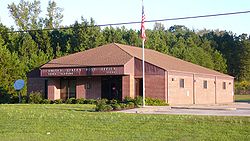Town of Vance [1] | |
|---|---|
 The U.S. Post Office in Vance, Alabama | |
 Location of Vance in Bibb County and Tuscaloosa County, Alabama. | |
| Coordinates: 33°09′45″N87°15′04″W / 33.16250°N 87.25111°W [2] | |
| Country | United States |
| State | Alabama |
| Counties | Tuscaloosa, Bibb |
| Area | |
• Total | 10.21 sq mi (26.44 km2) |
| • Land | 10.18 sq mi (26.36 km2) |
| • Water | 0.031 sq mi (0.08 km2) |
| Elevation | 545 ft (166 m) |
| Population (2020) | |
• Total | 2,092 |
| • Density | 205.5/sq mi (79.36/km2) |
| Time zone | UTC-6 (Central (CST)) |
| • Summer (DST) | UTC-5 (CDT) |
| ZIP code | 35490 |
| Area codes | 205, 659 |
| FIPS code | 01-78264 |
| GNIS feature ID | 2406787 [2] |
| Website | townofvance |
Vance is a town in Tuscaloosa and Bibb counties in the U.S. state of Alabama. As of the 2010 census it had a population of 1,529. [4] It is most famous for the Mercedes-Benz U.S. International plant, currently the only one in North America.
Contents
The Tuscaloosa County portion of Vance is part of the Tuscaloosa Metropolitan Statistical Area, while the Bibb County portion is part of the Birmingham – Hoover Metropolitan Statistical Area.



